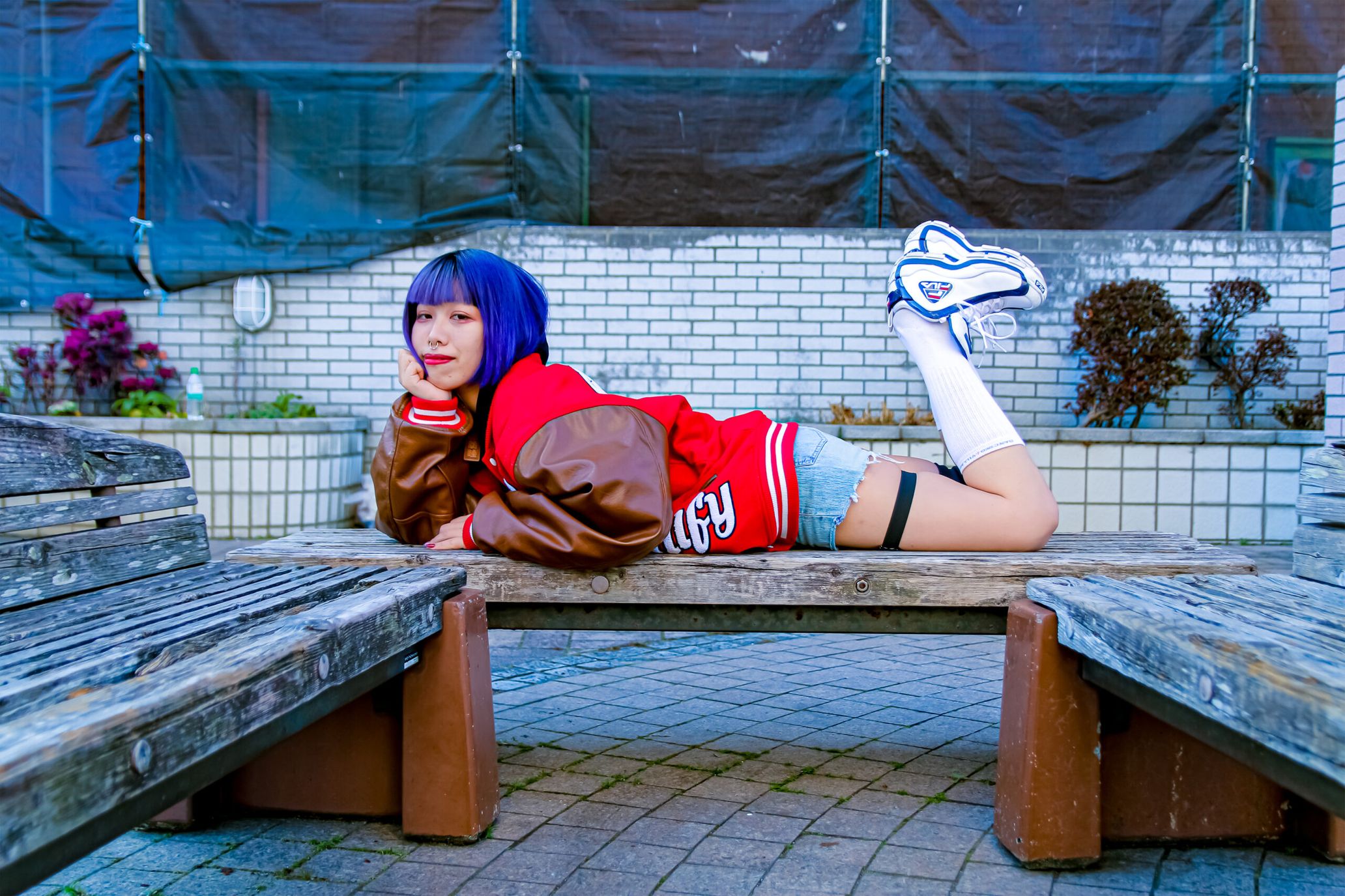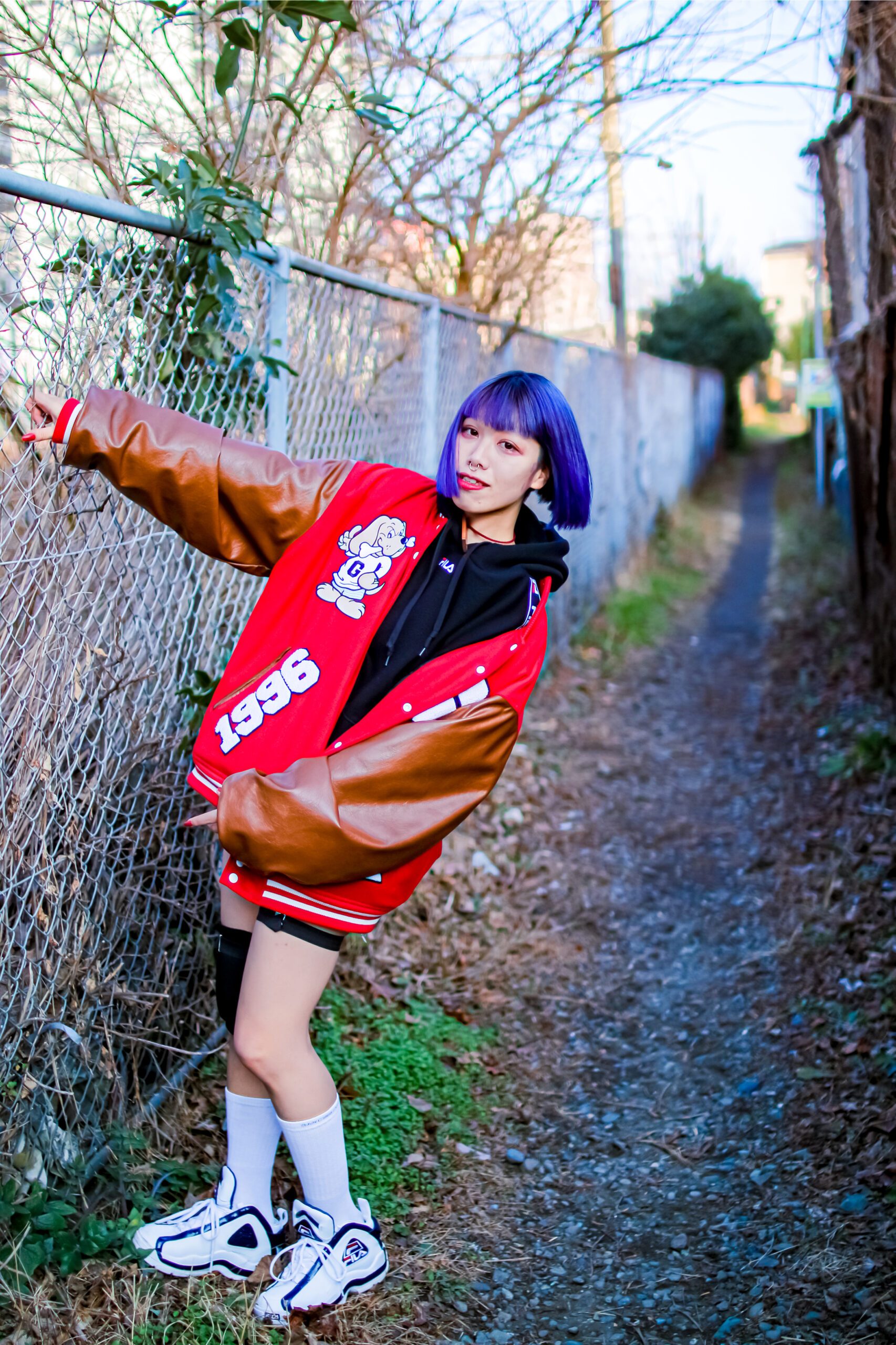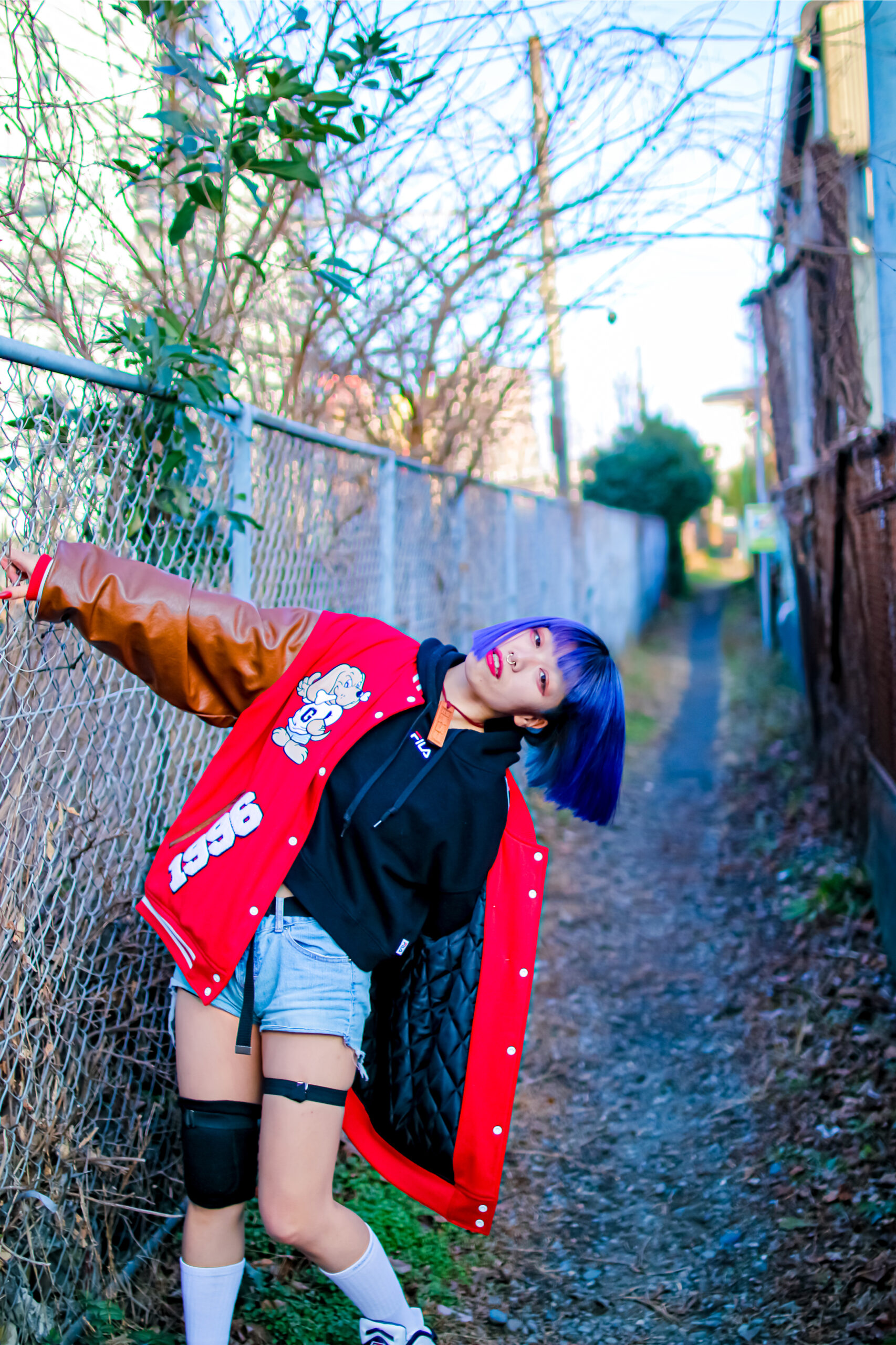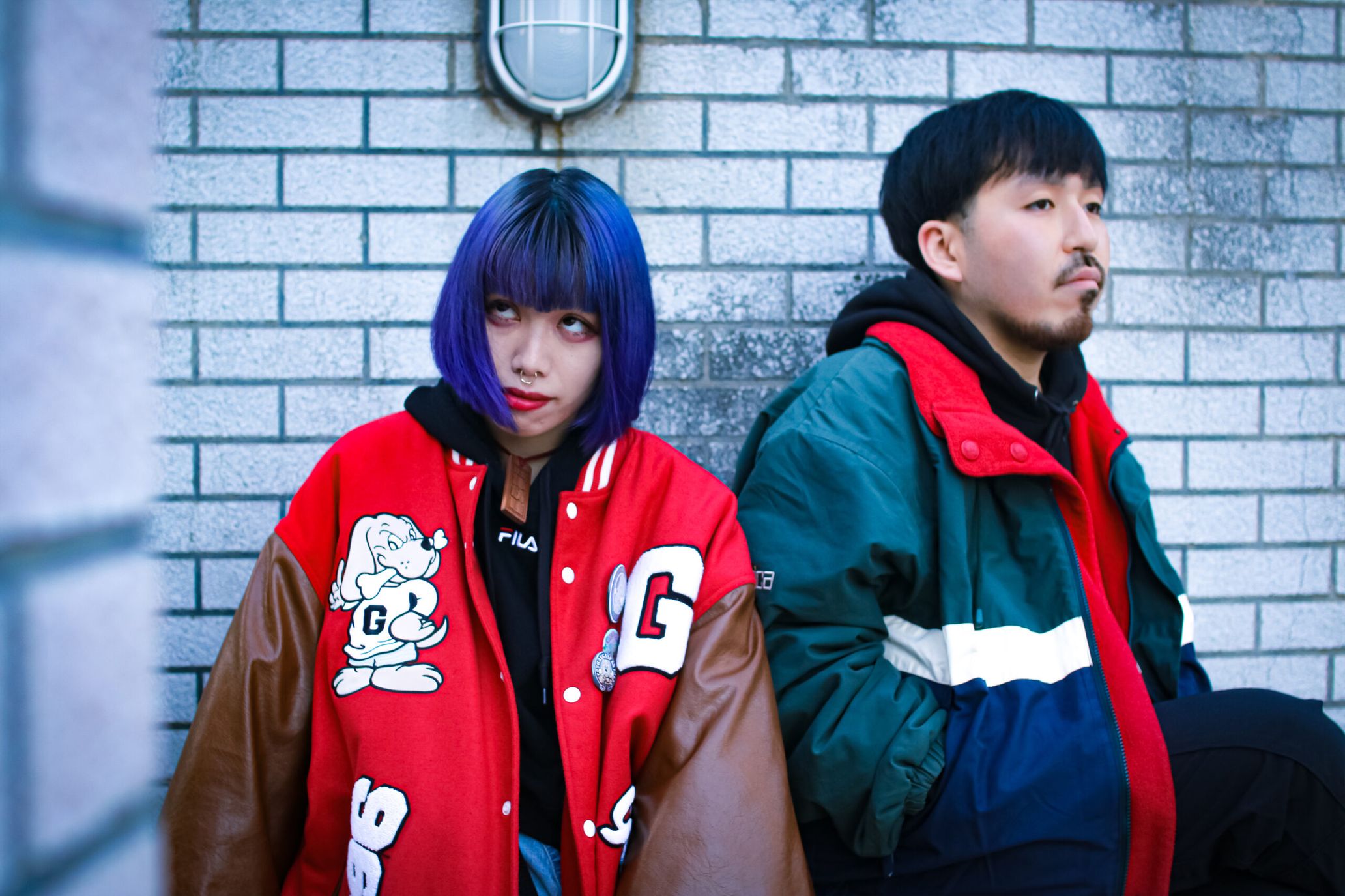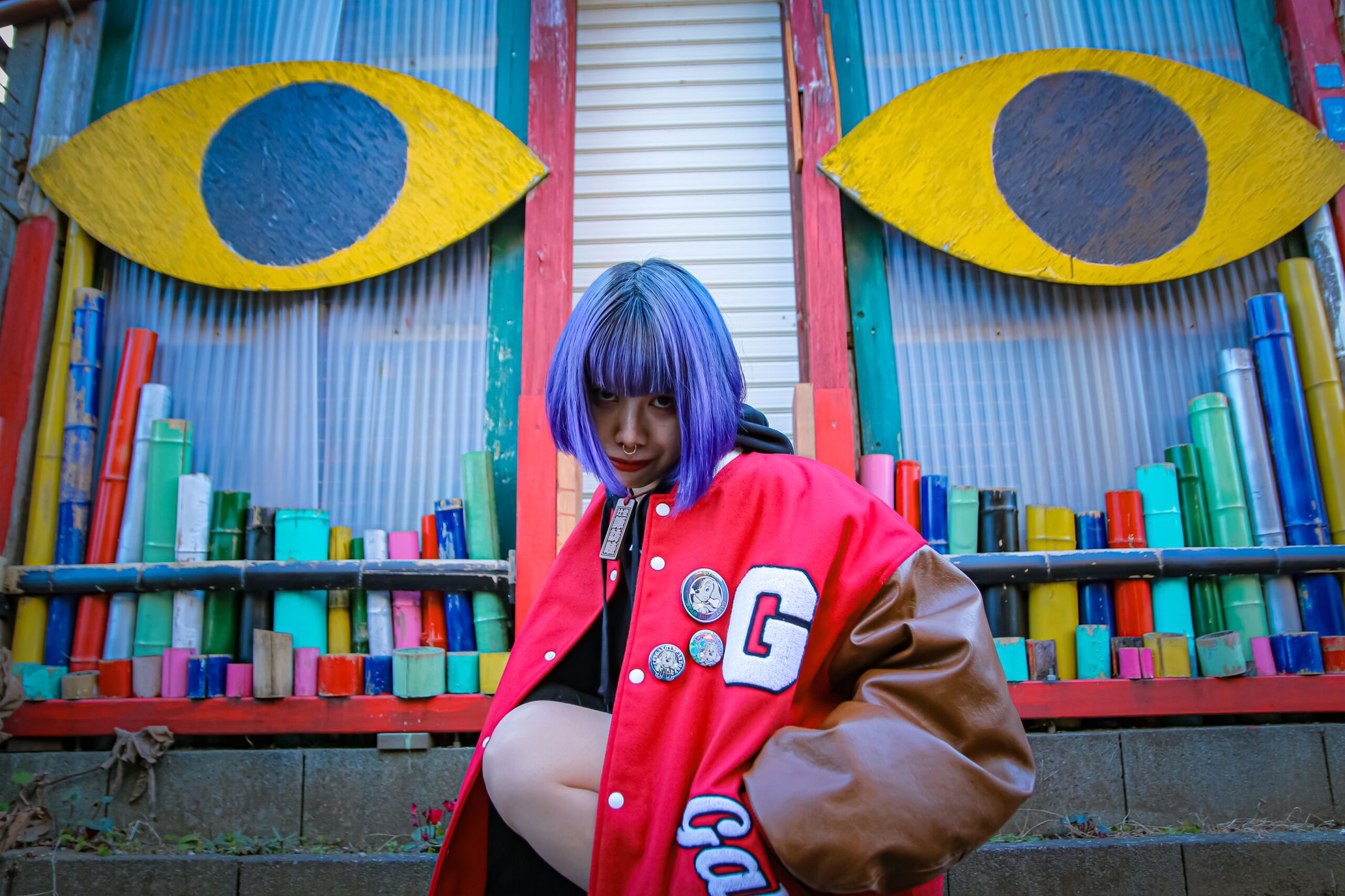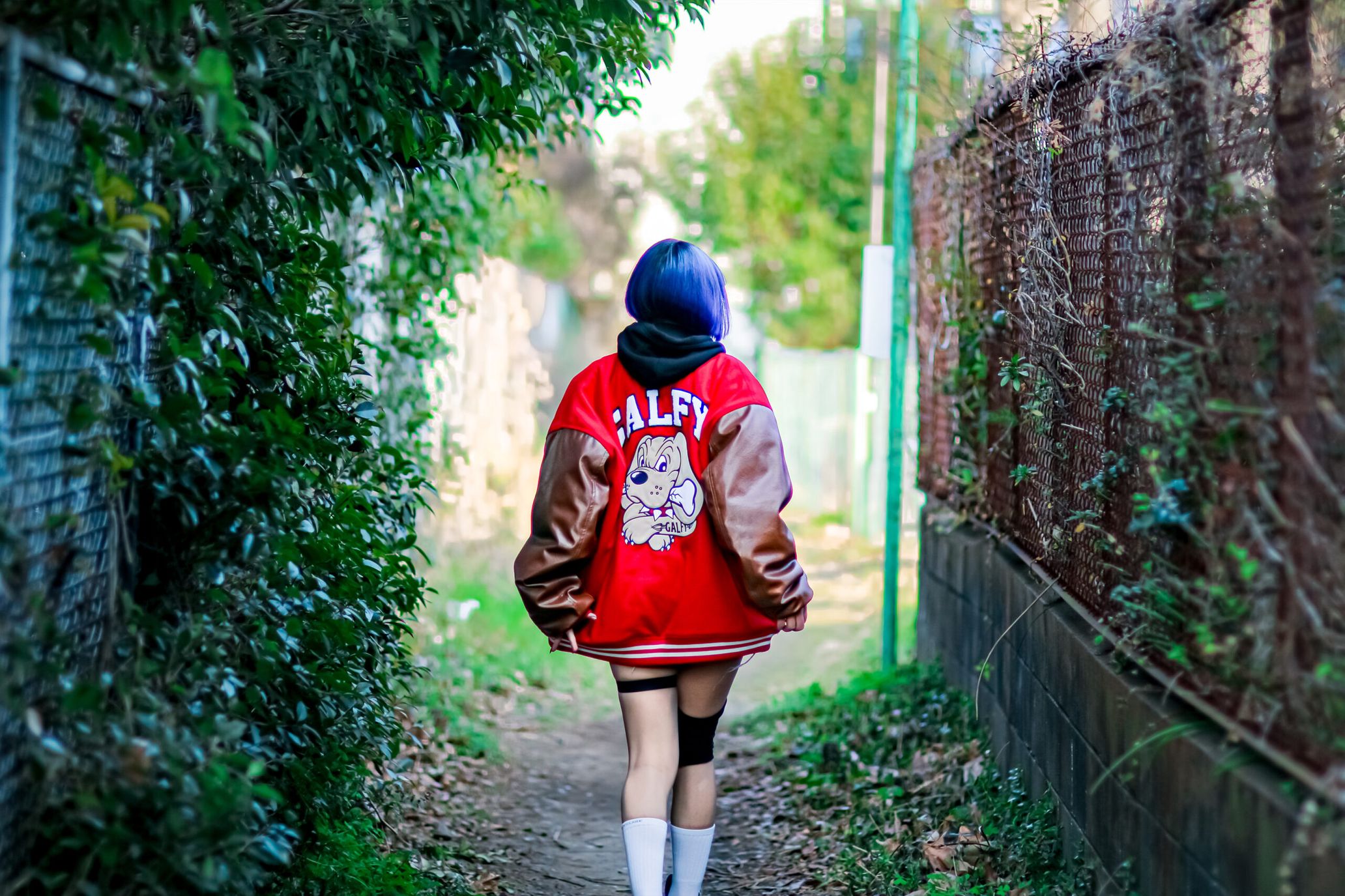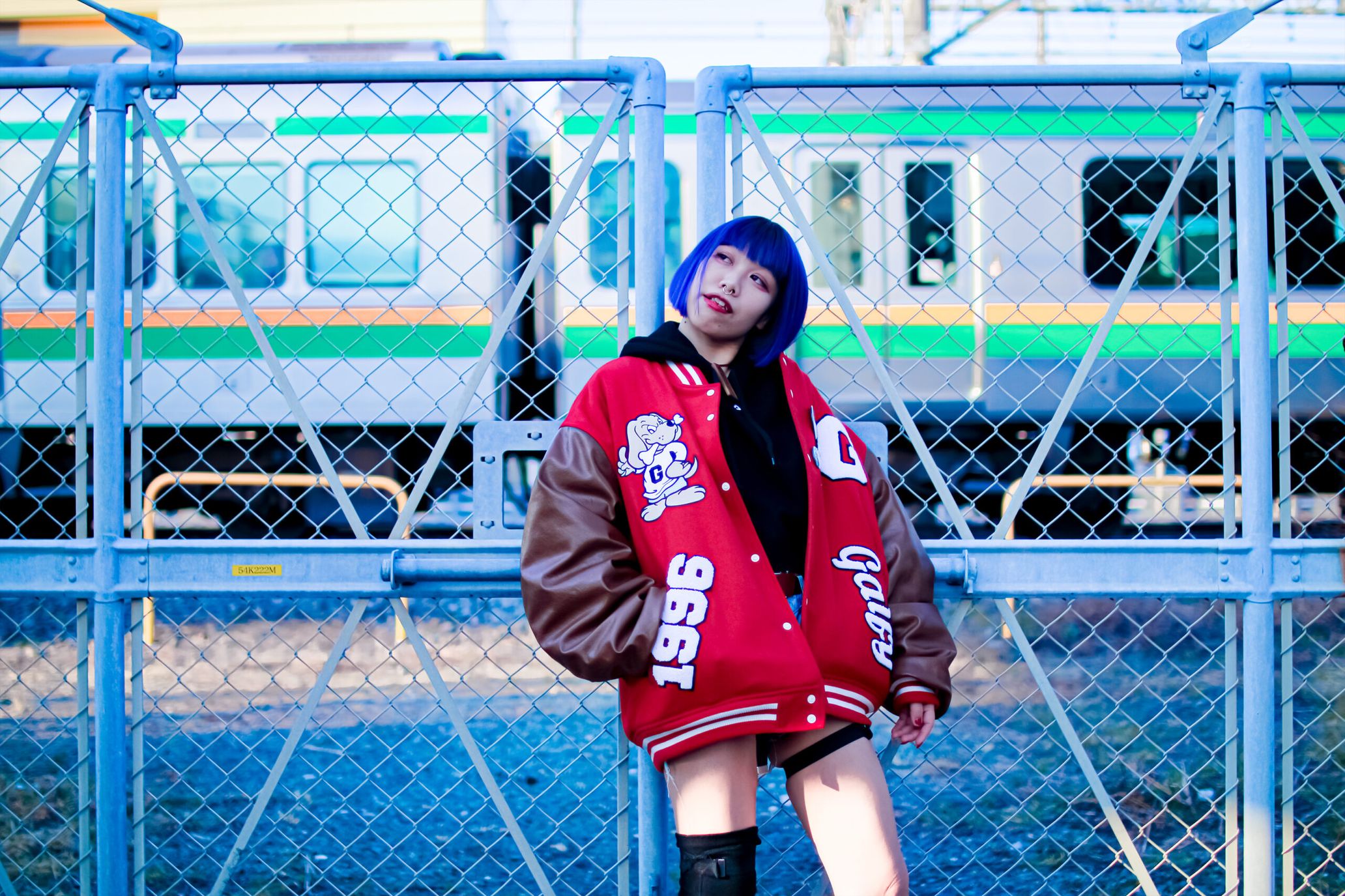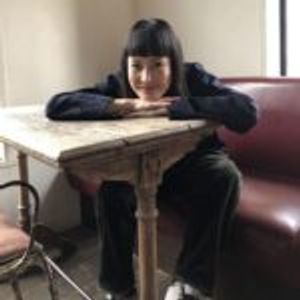The Japanese hip-hop scene is pursuing its own unique path, showing a distinct form of evolution. This tendency seems to be accelerating under the COVID-19 pandemic.
One day under the pandemic, I was driving to an outdoor party and suddenly heard an impressive rap flow. The venue was right in front of me, but I remember pulling my car into a convenience store parking lot and listening to it again. Then that night, I was shocked to see rapper Nakamura Minami’s live performance, which literally was an explosion of energy.
She appeared with her colorful hair in a bob cut with bangs, wearing black eyeliner around her eyes and bright red lipstick, the so-called Matsuri-bayashi (Japanese festival music) makeup that she had been familiar with since childhood. Her hip-hop and punk style has not changed since her debut, as she wears a wooden tag around her neck that reads “Tsujido Suwa Mutsumi,” to show her identity as a native of her town Tsujido, Kanagawa. She experienced homelessness in her early music career as a member of a popular rap group and has been steadily making her way as a full-fledged rapper since turning solo in 2019.
Produced by andrew of Japanese record label and producer team TREKKIE TRAX, all of Nakamura Minami’s music releases have received high attention, and especially in a collaboration tune with British producer Roska, her interesting use of Japanese language transcends the language boundaries and attracted listeners from foreign countries as well. And I am sure I was not the only one who felt her genuine love for her own music and the listeners dancing on the floor at the show under the COVID-19 pandemic, where she was finally able to hold the microphone.
What kind of rapper is Nakamura Minami, who is full of tremendous charm and is expected to make even greater strides in the future? Along with Minami, we asked her producer andrew to join us and interview her in her hometown, Tsujido.
The experience of Ohayashi may have led to rapping
——You were born and raised in Tsujido, a resort area of Kanagawa. What was your childhood like?
Nakamura Minami (Nakamura): Both of my parents are from Tsujido, but they divorced when I was about three years old. My mother took me and my brother and moved to Tsujido, where my mother’s family lived, before I entered elementary school. My mother was an alcoholic and was neglectful, so the neighbors took care of us. That is how I was able to survive, and the people who took care of me were involved in festivals at the neighborhood association.
I remember that when I was playing in the park with my classmates, at 5:30 p.m., the friends would all go to the town hall to practice Ohayashi (musical accompaniment for festival). After going to see them several times, I was officially allowed to play the Ohayashi. Until then, I had never had anyone recognize my worth, nor did I have any goals for myself, so I didn’t really have the joy of being alive. I wanted to be able to play the taiko well by the time of the summer festival. Since then, I have devoted my whole life to the festival, and I am still involved in it as a board member and instructor.
——You had such a tough childhood. …… And you found something you were passionate about, taiko.
Nakamura: That’s right. Every year in Tsujido, there is a Yoimiya Festival on July 26th, and each neighborhood association plays taiko drums as a team. The next day, the 27th, in the Reitaisai festival, the floats gather at Yotsutsuji, the origin of the town’s name Tsujido, and everyone faces each other there and beats the taiko drums. Then the mikoshi (portable shrines) would be set up on the grounds of the shrine, and there would be more drumming. So I would think about how I could stand out even as a child. And important thing here is to pass on the traditional culture we have been taught to the younger generation and preserve it. So, when you reach junior high school age or older, you join a preservation society and become an instructor. Since I started teaching taiko to children in this way, I felt more responsible than ever to do it properly.
——So you became absorbed in Ohayashi. But what was it that led you to become homeless and start rapping?
Nakamura:Ohayashi was all I had to live for, yet I moved to Tokyo and became homeless. There was a period of time when I was moving from one place to another, from my relatives to the homes of friends whose families I had become friends with through Ohayashi, but I had a big problem to deal with and decided to leave my hometown. So I left for Tokyo when I was 19 years old to make a decent living by earning money on my own. Normally one would rent a house and start living alone, but I went to Tokyo and started living on the streets. “I don’t want to be taken care of by strangers.” “I would never stay at a house other than a friend’s!” I think I ended up living on the street because of feelings like these.
——So you had a strong feeling that you would not be taken care of by strangers or adults?
Nakamura: Yes, that’s true. But the twice-monthly Ohayashi practices in my hometown still meant so much to me, so I earned money in Tokyo and always returned to Tsujido twice a month. Around that time, the leader of my former group (kamui of TENG GANG STARR) was teaching rap at a sort of community center, and that’s where I started rapping.
My mom used to listen to hip-hop and R&B in the car when I was a kid, and I used to listen to hip-hop when I was in high school, so I was familiar with it. But I never thought I would be rapping. Now I can tell my stories in my own words, but at the time I couldn’t speak very well. But since I started writing words, I have come to understand how important it is to put into words what I want to express.
——I see how good it was for you to put your feelings into words. And then, you took the microphone and began to speak your own words?
Nakamura:Yes. I felt that rapping was fun, and the sound was pleasant. With each rhyme, I was like, “Oh, it feels so good!” At that time, I felt like I was just saying whatever I wanted to say and rapping about things that I shouldn’t have said. Haha.
——Since you were playing the taiko drums, you must have had a good sense of rhythm.
Nakamura:In terms of what I have learned in ohayashi, I wrote down what had been passed down orally on sheets of paper, not in a form of musical notation, but in onomatopoeic words such as “ten” and “teretsuku” to memorize how the drumbeats goes on. I later realized that this was different from the rhythm in modern music, but at the time I believed that I had a good sense of rhythm. Of course, there are many people who have developed a sense of rhythm through this kind of experience, but in fact, one of the group members said to me, “You have a really bad sense of rhythm!” Haha. He was like, “You took taiko lessons, didn’t you?” And I was like, “Huh?” Reconsidering that, the ohayashi I learned has been passed down orally, so it is different from Western rhythms. So I may not have developed a sense of rhythm through Ohayashi, but I think it is connected to rap in terms of how I express myself.
Nakamura Minami “Ride (Prod.andrew) “
ZEN RYDAZ feat. Nakamura Minami “CANCANCAN”. She The world view linked to her background is presented on the hook.”CANCANCAN” is the sound of Japanese shoes “GETA”. This will remain in the ears of those who hear it
Whether I am rapping as a solo or as a guest performer, I always try to keep the “now” in mind
——How did you improve your skills in terms of rapping and performance?
Nakamura:When I was in a group, I had the leader look after my raps, but I think the turning point came when I started thinking about doing it solo. Also, when I started getting invited to live shows, I started to update how I presented myself live. I used to perform quite intensely and I have been told not to come back because of it. Haha.
andrew:Nakamura Minami was originally involved in noise and hardcore bands, so in the early days of TENG GANG STARR (hereinafter referred to as
TENG), she still had that vibes, and her performance gradually became more hip-hop-like from there.
Nakamura:Yes, when I was in a band, we used to do some pretty crazy performances, such as poetry readings with guitar accompaniment and pianica solo shows. This was the band I was in with my friends when I was homeless.
——Do you have any particularly memorable episodes from your homeless days when you were trying to get out into society?
Nakamura:It was a good story for me, but when I was homeless, I used to name stones I found on the street and sell them. I thought if I could meaning to the stones I picked up on the street, that would make people happy. Then I had an unforgettable encounter. Around the time I started rapping and performing at large venues, someone came to my shows saying that he had bought one of my stones. I received a message from this person saying “I bought your stone in the past. I will support you! “.
——Wow!!!. By the way, how much did you sell those stones for?
Nakamura: ●●● yen. Haha. I was selling them half-forcibly, saying “I think you should buy it!” I was also sitting down on the street with four girls from the next town to listen to the stories of people passing by. We were there to just listen to their stories, but if people liked how we listened to, we asked them to pay us. Everyone else was doing it properly, but the passing train was too loud for me to hear people’s voice, or maybe I was simply not listening to them. Eventually I started to think that it would be better to tell the story myself.
——As a result, maybe that led to rapping. What do you keep in mind most when writing lyrics?
Nakamura:When I was in TENG, I was rapping about my past, or rather, a kind of thug life I had been in. For example, I dealt with the episode of meeting Masashi Tashiro (a former Japanese television performer) when I went to visit my mother in the DARC (drug addiction rehabilitation center). But after I started going to nightclubs often, watching my friends on stage and dancing on the floor until morning, I was able to respond in my own way to the sounds and pleasant words I heard while dancing there. So I began to rap about the “now.” So now, whether I am rapping as a solo or as a guest performer, I always try to keep the “now” in mind.
Nakamura Minami “Maneater (Prod.andrew) “
Morgan Hislop “Mirror Mirror feat. Nakamura Minami “
I realized that a song with my words that I felt pleasant could communicate with people even beyond the language barrier
——Now, you are attracting attention overseas as well. How do you feel about that?
Nakamura:One of the things that made me happy was an overseas DJ who played “Pree Me feat. Nakamura Minami”, which I made with a London-based producer Roska, on Boiler Room (an online music broadcasting platform with bases around the world). The non-Japanese people were really excited about my rhymes in the song, despite the fact that the lyrics were mostly in Japanese. So I realized that a song with my words that I felt pleasant could communicate with people even beyond the language barrier. Of course, it would be more fun if I could convey the meaning of the words as well.
——andrew-san, you have been in charge of Nakamura Minami
’s song as a sound producer. How do you feel about that moment in Boiler Room?
andrew: Recently, I think that raps and songs from non-English speaking countries are becoming more and more appreciated in the context of club music. As for the session in which Nakamura’s music was played in the Boiler Room, it featured Daytimers UK, a South Asian collective based in the UK, who mixed Asian and British musical styles. The session acquired a distinguished reputation in the UK, and the clip capturing the moment when a DJ played “Pree Me” was snipped and uploaded on Twitter and Instagram. I felt it was picked up as one of Japanese hip-hop and dancehall tunes that have interesting sounds of the phrases used in the song. I don’t think people understood what she was rapping about, but I think the way she uses language and our sound approach fit what they needed.
——From your point of view, what do you find attractive about Nakamura Minami as a rapper?
andrew:Nakamura Minami herself likes and respects traditional things, but I think she also has a deep-seated desire to break down or reconstruct those traditions. I make suggestions to her, saying, “There is a genre or scene like this, and how about this approach?” What is interesting is that her feedback is new and different from what I expected. Of course, we discuss and adjust some of these differences, but it is interesting.
Roska “Pree Me feat. Nakamura Minami
——How was your collaboration with UK based artist Roska on “Pree Me feat. Nakamura Minami?
Nakamura: It was so well received that Spotify’s total view count for a song on reached its limit for that function.
——How did you get to know Roska?
andrew:Seimei from TREKKIE TRAX had been in contact with Roska for a while, and he contacted me because he was going to perform in Japan and wanted to collaborate with a Japanese artist. Nakamura Minami was one of the artists I introduced to him, and he said, “She’s so dope.” Until then, Nakamura Minami had rarely rapped in club music such as techno and dancehall. But she had started going to nightclubs a lot, so I thought we could make something interesting. From there, I recorded Nakamura Minami’s rap and sent it to Roska for production. He himself had been paying attention to the Asian scene from a very early stage, and those scenes were gradually becoming known abroad, especially in London. So I think it was a mixture of these things that led to a local DJ playing our music at the Boiler Room.
——Do you get many offers from overseas artists for Nakamura Minami?
andrew:Maybe because our songs with Roska have increased the number of overseas listeners, we are getting a lot of offers from overseas producers. In particular, we are getting more offers for remixes, a cappella vocals, and offers to write and create originals together.
——Once this pandemic is over, you may be able to do some shows overseas.
Nakamura:Yeah, I haven’t been able to meet all the people I wrote songs with, so I would like to go overseas. I would like to go to meet them and greet them with a loud voice, “Konnichiwa !!!!!!!!!!. ” Haha.
I want to continue to work on both hip-hop and Matsuri for the rest of my life
——Are there any new goals or prospects that you would like to challenge yourself next?
Nakamura:I have been doing music for a long time, but last year I wrote a song and contributed it to the other artist for the first time. I really enjoyed that experience, but based on that, I would like to focus on performing the songs I wrote myself at my own shows. I would also like to visit overseas producers. It is equally important for me to participate in the Matsuri (Japanese traditional festival) in Tsujido held every year on July 26 and 27. Matsuri is my lifestyle, so I would like to continue to work on both hip-hop and Matsuri for the rest of my life.
——andrew-san, how do you hope to produce Nakamura Minami in the future?
andrew: Even if I envisage something for her in advance, she’s a person who pops up from totally different place. Haha. I have written various songs for her in the past, but her reactions have often come back from completely different directions, so I would rather be very interested in enjoying that kind of unpredictability. Based on that feeling, I want to make more connections with people overseas. Right now I am sowing all sorts of seeds in various places, so I hope that when the pandemic is over, there will be a moment when they bloom explosively.
Nakamura Minami
Born in Tsujido, Kanagawa Prefecture on September 30, 1995, she has been into the festival music of her hometown Tsujido since she was a child, and experienced homelessness at the age of 19. In 2015, she was spotted by kamui and became a member of the hip-hop unit TENG GANG STARR. After shifting her focus onto a solo career in 2019, she has been developing her own form of music not only in the field of hip-hop, but also in club music scene. She has released a number of songs including collaborative tunes with overseas producers, such as “Pree Me feat. Nakamura Minami” with Roska and “Ice Cream feat. Nakamura Minami” with Anna Lunoe. Also her releases with TREKKIE TRAX CREW include “Ride,” “kokodoko,” “Reiwa” and “3D Remix.” Many domestic and international producers have also worked on remixes of her songs.
Instagram: @namcooooo
Photography Yousai Kumada
Translation Shinichiro Sato(TOKION)

